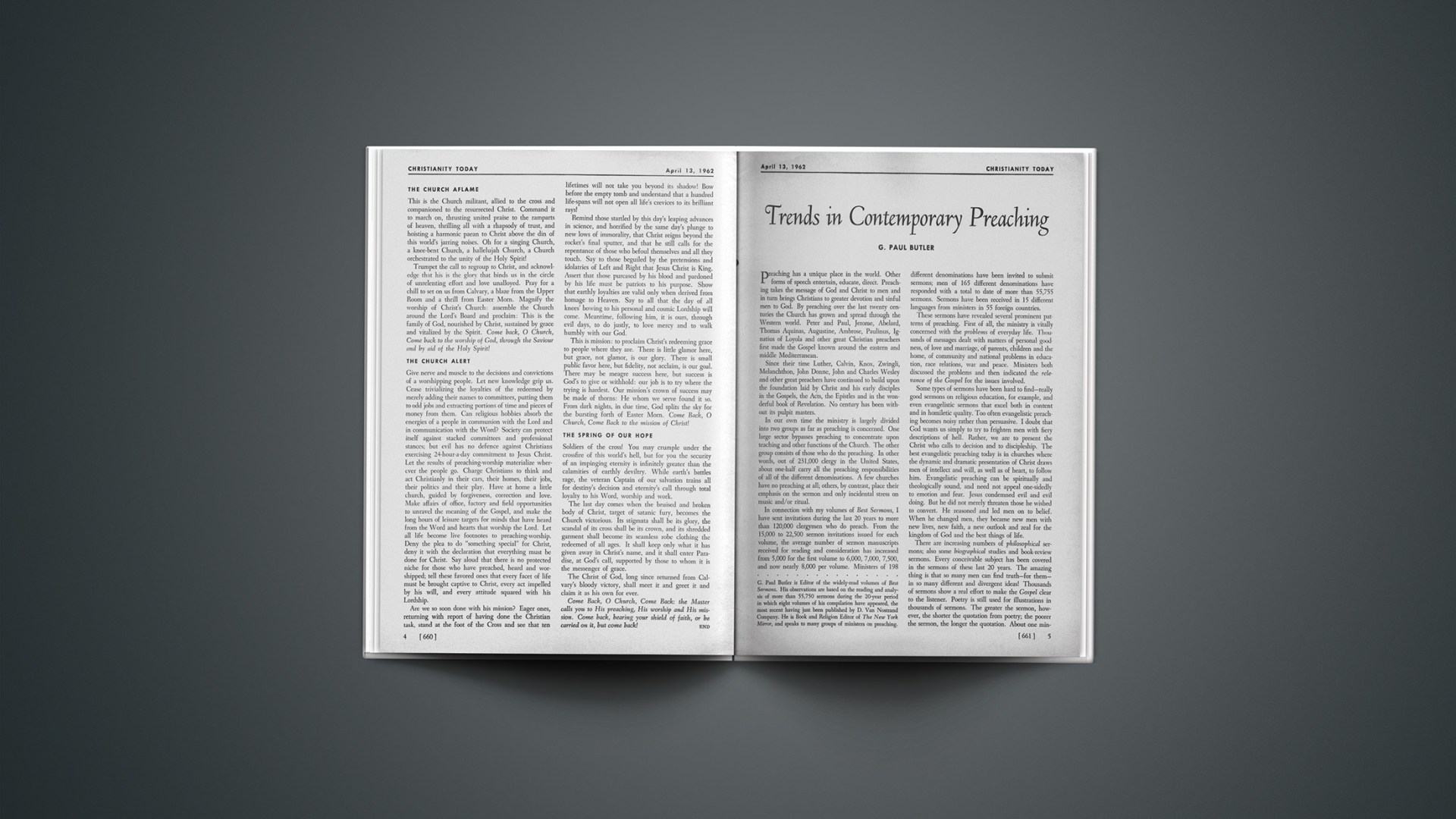Preaching has a unique place in the world. Other forms of speech entertain, educate, direct. Preaching takes the message of God and Christ to men and in turn brings Christians to greater devotion and sinful men to God. By preaching over the last twenty centuries the Church has grown and spread through the Western world. Peter and Paul, Jerome, Abelard, Thomas Aquinas, Augustine, Ambrose, Paulinus, Ignatius of Loyola and other great Christian preachers first made the Gospel known around the eastern and middle Mediterranean.
Since their time Luther, Calvin, Knox, Zwingli, Melanchthon, John Donne, John and Charles Wesley and other great preachers have continued to build upon the foundation laid by Christ and his early disciples in the Gospels, the Acts, the Epistles and in the wonderful book of Revelation. No century has been without its pulpit masters.
In our own time the ministry is largely divided into two groups as far as preaching is concerned. One large sector bypasses preaching to concentrate upon teaching and other functions of the Church. The other group consists of those who do the preaching. In other words, out of 231,000 clergy in the United States, about one-half carry all the preaching responsibilities of all of the different denominations. A few churches have no preaching at all; others, by contrast, place their emphasis on the sermon and only incidental stress on music and/or ritual.
In connection with my volumes of Best Sermons, I have sent invitations during the last 20 years to more than 120,000 clergymen who do preach. From the 15,000 to 22,500 sermon invitations issued for each volume, the average number of sermon manuscripts received for reading and consideration has increased from 5,000 for the first volume to 6,000, 7,000, 7,500, and now nearly 8,000 per volume. Ministers of 198 different denominations have been invited to submit sermons; men of 165 different denominations have responded with a total to date of more than 55,755 sermons. Sermons have been received in 15 different languages from ministers in 55 foreign countries.
These sermons have revealed several prominent patterns of preaching. First of all, the ministry is vitally concerned with the problems of everyday life. Thousands of messages dealt with matters of personal goodness, of love and marriage, of parents, children and the home, of community and national problems in education, race relations, war and peace. Ministers both discussed the problems and then indicated the relevance of the Gospel for the issues involved.
Some types of sermons have been hard to find—really good sermons on religious education, for example, and even evangelistic sermons that excel both in content and in homiletic quality. Too often evangelistic preaching becomes noisy rather than persuasive. I doubt that God wants us simply to try to frighten men with fiery descriptions of hell. Rather, we are to present the Christ who calls to decision and to discipleship. The best evangelistic preaching today is in churches where the dynamic and dramatic presentation of Christ draws men of intellect and will, as well as of heart, to follow him. Evangelistic preaching can be spiritually and theologically sound, and need not appeal one-sidedly to emotion and fear. Jesus condemned evil and evil doing. But he did not merely threaten those he wished to convert. He reasoned and led men on to belief. When he changed men, they became new men with new lives, new faith, a new outlook and zeal for the kingdom of God and the best things of life.
There are increasing numbers of philosophical sermons; also some biographical studies and book-review sermons. Every conceivable subject has been covered in the sermons of these last 20 years. The amazing thing is that so many men can find truth—for them—in so many different and divergent ideas! Thousands of sermons show a real effort to make the Gospel clear to the listener. Poetry is still used for illustrations in thousands of sermons. The greater the sermon, however, the shorter the quotation from poetry; the poorer the sermon, the longer the quotation. About one minister in each thousand preaches in blank verse; one younger man preaches in blank verse every Sunday of the year!
Today, the better the sermon, the shorter it tends to be—18 to 20, 22, or 25 minutes. Generally speaking, the leading ministers and best preachers use more short illustrations—rather than a few long stories. The best preaching is done in the great city churches of New York, Washington, Boston, Dallas, New Orleans, Miami, Los Angeles, Chicago. A distinct difference marks most northern from southern preaching. In the South long illustrations—perhaps three or four—are customary in a sermon, while northern sermons may have 30 to 40 short, pithy allusions. Strong preachers are not limited to any specific locale, however, but may be found anywhere.
The highest tribute I can pay to contemporary preaching—and this I say after reading thousands of sermons—is that almost every sermon shows careful preparation. Increasing numbers of men write out their sermons in full; most try to deliver them without reading from the manuscript. Sermons today indicate also that the better preachers are well read. I know men who keep 12 to 50 books on hand for ready reading in order to keep up with current ideas on religious and secular matters. Ministers today show a real desire to preach a spiritual message that is relevant to daily living. They try, too, to preach in an oral style that employs excellent form and word choice. Preaching today is a mature art and our great preachers are artists in the pulpit—the pulpit where God is proclaimed.
The Glorious Themes
What glorious themes the Christian Church has to proclaim! What all the other world religions desired and sought for 5,000 years Christ gave to his followers: salvation from sin, life eternal, resurrection to a life with God the Father. If we cannot preach sermons that lift our congregations we need to return to the New Testament and again read its immortal story, be it in the King James, Moffatt, the Revised Version, or the fine new J. B. Phillips’ translation. Preaching is something to be experienced. It is an experience of man with God, an opportunity to bring other men face to face with an eternal God who waits for them. If all our ministers took hold of this great fact they would never again lose time in getting at their desks to prepare their weekly sermons! Thousands of sermons every week, all in this spirit of purpose and responsibility, would bring a revival greater than all the annual revivals ever envisioned.
My search for sermons in conjunction with the Best Sermons volumes is, I believe, the widest that has ever been conducted. It is a great privilege to read the best sermons of thousands of ministers all over our country and all over the free world. In these sermons the men reveal their preparation, their reading, their attempt to bring the Gospel to the people. Several times I have had the thrilling experience of being the first to discover young ministers of ability in the pulpit and to give them their initial sermonic recognition in print. Hundreds of men write me that preparing a sermon for submission to Best Sermons puts them at their best, makes them write with particular care. Many appreciate the discipline involved and others then make a habit of such careful preparation and find they become better preachers thereby.
I am sometimes asked: “How can you tell about a man’s delivery from the written manuscript?” One can’t, completely, of course. Yet it is amazing how much of a man’s style and delivery are revealed in his word choice, sentence structure, his underlining or italics, and even in his punctuation! By his wording and statements you can sense, too, what a minister feels. In a manuscript you can’t see a man’s gestures, of course, nor the flash of his eyes, but you can almost imagine how he would react as you read and absorb what he says. Herein lies the importance of style, of oral style. Men need to practice this oral style, to hunt for words that are primarily for spoken expression rather than for written productions. The ideal, of course, so combines the elements of oral and literary excellence that the sermon both reads and delivers well.
Some Worthwhile Disciplines
Young ministers should work hard at sermonizing. In seminary they ought to read other men’s sermons, perhaps even copy and adapt the style of older ministers. As soon as possible, however, each man should faithfully develop his own style, form, and delivery. To write 1,800 to 2,500 words for his sermon every week of his life is a responsibility worthy of a man’s very best efforts. Some men are overwhelmed and give up. But those who go on, who in time sense the incomparable joy that their weekly sermons are taking hold, who see a response in the congregation, are uniquely rewarded for long hours spent alone in the study. Each man must develop his own study habits, even as he does his own style. He dare not neglect either if he wishes to be what he was called to be, a man of God speaking in the place and house of God.
Any man who knows preaching at all readily admits that the greatest sermons come through divine unction. Hundreds of men during the nearly 2,000 years of the Christian Church, Augustine at Canterbury, the Wesleys, George Whitefield, Dwight L. Moody and Billy Sunday—and men in every generation—have made the pulpit respected by their powerful preaching ministry. Thousands of sermons every week, however, by the patient, hard-working pastor-preachers of churches all over our country, in every city and village, in town and rural community, are the result of sheer hard work, study, meditation, prayer, careful outlining and/or writing. All ministers at times become discouraged. To these I would like to say: preach on, prepare even more diligently. Wait upon God! Men will hear your message if you bring it with fire in your soul and intelligence in your words and never lose touch with your people.
Inspiration is the gift of God, of the Holy Spirit, but “inspiration” in the popular sense, is a fantasy. Hunt and nurture your ideas in quiet study and meditation, in pastoral visiting and counseling, in steady, hard work with your pen or typewriter. This discipline will yield worthy sermons. Develop your distinct style, vocabulary, and pulpit delivery. You can make your own place in the pulpit. When a fine sermon electrifies a congregation with its message and conviction, we are wont to call it “inspired”; actually, it may mainly be the result of full and devoted preparation. What we term “inspiration” may combine many factors whether the sermon be by a Peter the Hermit, a Jonathan Edwards or a man of our own day. By this I do not mean to imply that I do not believe in divine stimulation. Rather, I believe we should do what we can and leave its empowerment to God.
After reading thousands of sermons during the last 20 years, I believe more than ever that effective preaching is the most vital function of our contemporary Protestant churches.










